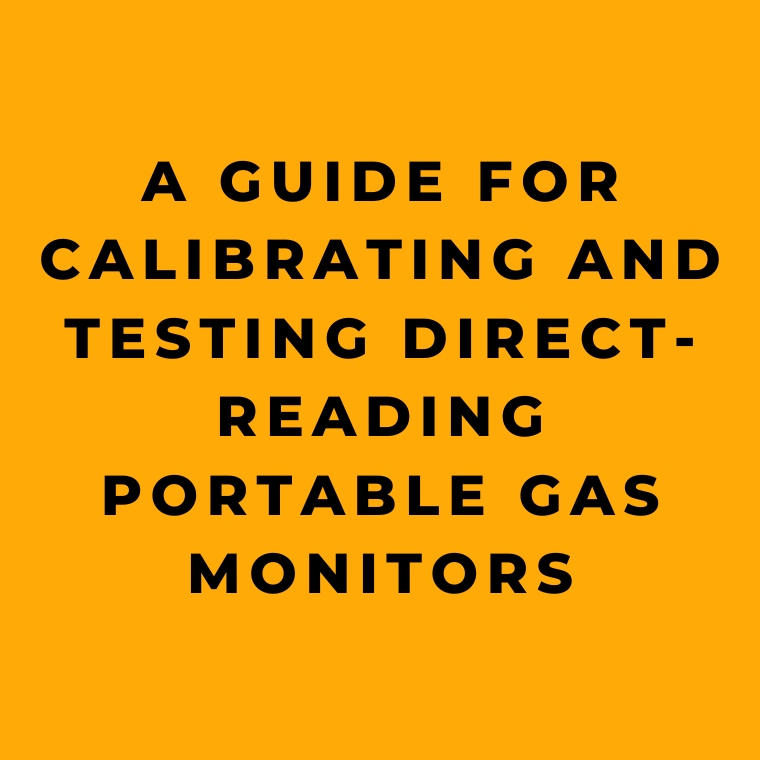Today we’re going to talk about the crucial role that direct-reading portable gas monitors (DRPGMs) play in keeping workers safe from invisible gas hazards. By regularly maintaining and calibrating these instruments, you can ensure their accuracy in detecting harmful gases in the workplace. Always follow the manufacturer’s advice when it comes to calibration.
DRPGMs are designed to keep workers safe by alerting them to toxic gases, as well as oxygen-deficient and combustible atmospheres that can be found in workplaces like confined spaces, manholes, and other enclosed areas. OSHA standards require the use of gas monitors in various situations, and they recommend establishing standard procedures for calibrating and using DRPGMs, including documentation to verify proper maintenance and calibration.
If these instruments aren’t maintained or calibrated correctly, they can become inaccurate, leading to exposure to hazardous gases or oxygen-deficient environments. This can result in serious injuries, illness, or even death for workers. Moreover, flammable gas explosions can have catastrophic consequences, causing worker injuries and fatalities, as well as property damage.
The most reliable way to make sure a DRPGM is detecting gas accurately is to test it with a known concentration of gas. This process will confirm if the sensors are responding accurately and if the alarms are functioning correctly.
The International Safety Equipment Association (ISEA), established in 1933, is a trade organization for manufacturers of protective equipment, including DRPGMs. The ISEA suggests, at the very least, verifying the operational capability of these instruments before using them each day, with extra testing conducted as needed. This article incorporates recommendations developed by the ISEA.
Calibration: Your Ticket to Reliable Readings
Calibration is the essential process that ensures DRPGMs can accurately detect toxic and combustible gases, as well as oxygen deficiencies or excesses (which can lead to fires and explosions). Remember, workers shouldn’t rely on their sense of smell alone for detecting these hazards. Employers must make sure workers use these instruments in areas with potentially dangerous atmospheres.
Calibration is all about checking an instrument’s measuring accuracy against a known concentration of test gas. DRPGMs compare the sensor’s response to this test gas, and to ensure this comparison is valid, always check the calibration gas’s expiration date before using it. The instrument’s response to the calibration gas becomes the reference point.
Keep in mind that sensor responsiveness can change depending on workplace environmental conditions, like temperature and humidity. So, as much as possible, calibrate sensors in conditions that match (or closely resemble) the actual workplace environment. And always follow the manufacturer’s guidelines for proper calibration.
By establishing standard calibration procedures that follow the manufacturer’s instructions, company policies, and/or relevant regulatory guidelines, you can make sure DRPGM operators perform calibrations consistently and that the instruments remain accurate and operational. Employers should maintain calibration records for each instrument’s lifespan. This way, operators can quickly spot a DRPGM with a history of excessive maintenance, repairs, or erratic readings, and track sensor drift to know when replacements are needed.
Calibration Drift and Its Causes
“Calibration drift” occurs when an instrument’s reference point shifts, causing unreliable readings. All sensors experience calibration drift over time. Although an instrument with calibration drift can still measure gas quantities, it can’t provide an accurate numerical reading. To verify or update the reference point, perform daily calibration checks or full calibrations with a traceable gas concentration—or even more often if needed. Calibration drift typically results from:
- Degradation due to phosphate exposure
- Degradation of phosphorus-containing components
- Degradation of lead-containing components
- Gradual chemical degradation of sensors and normal drift in electronic components over time
- Use in extreme environmental conditions like high/low temperatures and humidity, or high levels of airborne particulates
- Exposure to high concentrations of target gases and vapors
- Exposure of catalytic hot-bead LEL sensors to volatile silicones, hydride gases, halogenated hydrocarbons, and sulfide gases
- Exposure of electrochemical toxic gas sensors to solvent vapors and highly corrosive gases
- Vibration or shock from handling and jostling the equipment, which can affect electronic components and circuitry over time
If any of these conditions occur or are suspected during use, operators should validate the DRPGM’s operability. When trying to calibrate after exposure to these conditions, the sensor often displays a failure message or won’t allow full adjustment of the reading. Harsh operating and storage conditions can impact instrument performance, causing inaccurate readings or even failure. A DRPGM might look undamaged during visual inspection, but internal damage could be present. In this case, the operator should replace the damaged sensor or have qualified personnel service it. Remember to follow the manufacturer’s instructions regarding sensor replacement and servicing.
Worker Safety: Top Priority for Consistent Calibration
I want to emphasize that the main reason for proper and regular instrument calibration is to deliver accurate gas-concentration readings that can prevent worker illness, injury, or even death. By calibrating instruments correctly, you ensure that DRPGMs accurately respond to the gases they’re designed to detect, warning users of hazardous conditions before they become dangerous. Some DRPGMs have two alarm levels: warning and danger. The warning alarm alerts operators and workers to elevated toxic gas concentrations and potential hazards. The danger alarm signals that the toxic gas concentration surpasses the programmed hazard threshold, indicating a toxic gas level above the warning and nearing hazardous levels. The DRPGM’s ability to provide warning or danger alarms at the correct concentration depends on its detection capabilities, accuracy in translating findings, and the presence of interfering gases (refer to “Calibration Drift and Causes” above).
Bump Tests, Calibration Checks, and Full Calibration Bump Test (or Function Check)
A bump test is a qualitative function check where a challenge gas activates all alarm settings as it passes over the sensors.
The purpose is to confirm that gas reaches the sensors and that all the instrument’s alarms work. A bump test doesn’t measure the instrument’s accuracy. The challenge gas concentration should trigger the DRPGM’s alarms.
Calibration Check or Full Calibration
To verify DRPGM accuracy, you can use two methods: a calibration check and a full calibration.
Each is appropriate under certain conditions.
A calibration check verifies that the sensors and alarms respond within the manufacturer’s acceptable limits by exposing the instrument to test gas. Operators compare the reading to the test-gas concentration (indicated on the cylinder containing the test gas). If the response falls within the acceptable range of the test-gas concentration (typically ± 10-20% of the test-gas concentration), the calibration check confirms the instrument’s accuracy. (Note: OSHA recommends checking with the instrument’s manufacturer for acceptable tolerance ranges.) Before conducting the calibration check, operators should “zero” the instrument (reset the reference point; in some cases, “zero air” gas may be needed) to ensure accurate results. The test-gas concentration should be high enough to trigger the instrument’s alarms during a calibration check.
If the calibration-check results are outside the acceptable range, the operator should perform a full calibration. A full calibration adjusts the instrument’s reading to match a known concentration (i.e., certified standard) of test gas. Test gas used for calibration should always be certified using a standard traceable to the National Institute of Standards and Technology (NIST):
https://www.nist.gov/metrology/metrological-traceability
When to Bump Test and When to Fully Calibrate
In the past, there’s been some confusion about proper calibration procedures and frequency. To clear this up, ISEA updated its position statement on instrument calibration in 2010, saying, “A bump test . . . or calibration check of portable gas monitors should be conducted before each day’s use following the manufacturer’s instructions.” If an instrument fails a bump test or calibration check, the operator should perform a full calibration before using it. If the instrument fails the full calibration, it should be removed from service, and the manufacturer should be contacted for assistance or service.
Calibration Guidelines Here are a few basic calibration rules for DRPGMs:
- Stick to the manufacturer’s guidelines for proper calibration. Operators can’t do any job, including DRPGM calibration, properly or safely without the right tools. The type and concentration of calibration test gas, sample tubing, flow regulators, and calibration adapters are crucial components in the calibration process. Testing to verify the gas monitor’s operation should be conducted in an environment that matches (or closely resembles) working conditions (e.g., temperature, humidity, atmospheric pressure).
- Always use a certified traceable test gas before its expiration date. The instrument’s accuracy is only as good as the test gas used to calibrate it. Ensure that the supplier can provide a certificate of analysis for every test-gas cylinder. The test gas concentration, especially for reactive gases like hydrogen sulfide and chlorine, remains stable only for a limited time. Never use a test gas past its expiration date.
- Train DRPGM operators on proper calibration methods. Most instruments are designed for field calibration, with detailed instructions available in the manufacturer’s user manual, training videos, or computer-based training modules. Employers should train and test everyone responsible for performing DRPGM calibration.
Conclusion
To wrap things up, folks, keeping workers safe from those sneaky, harmful gases in the workplace is all about proper use and regular calibration of those nifty direct-reading portable gas monitors (DRPGMs). Stick to the manufacturer’s guidelines, use only top-notch certified traceable test gases, and make sure your operators are trained up in the right way to calibrate these life-saving gadgets.
By putting standard calibration procedures in place and keeping a close eye on the performance of these instruments, we can help prevent workers from getting sick, injured, or worse – all thanks to avoiding exposure to those pesky hazardous gases or oxygen-deficient environments. So, let’s remember, the ultimate goal of staying on top of calibration is to keep the work environment safe and sound, making sure everyone can clock out at the end of the day and go home to their loved ones in one piece.
References:


